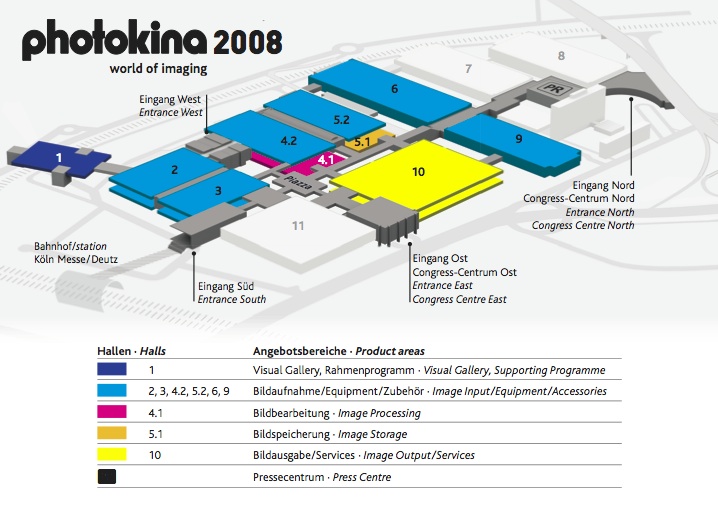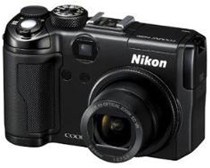
Apparently, the latest firmware update for the Nikon D3 is the source of leaked info on the 24.4 Megapixel Nikon D3X, which has been rumored for some time. Perhaps we will see the Nikon D3X at Photokina 2008. According to a forum poster at DPReview, the following was found:
The following strings are in the D3’s B-firmware file v1.10, starting at offet 3’614’640:
6048×4032 24.4 M
4544×3024 13.7 M
3024×2016 6.1 M
5056×4032 20.4 M
3792×3024 11.5 M
2528×2016 5.1 M
3968×2640 10.5 M
2976×1976 5.9 M
1984×1320 2.6 M
D3X
For the latest on the Nikon D3X, stay tuned to Photography Bay’s Nikon D3X Rumors page.



 Adobe Photoshop CS4: Adobe announced
Adobe Photoshop CS4: Adobe announced  Canon PowerShot G10: The PowerShot G10 digital camera offers serious amateur shooters and professional photographers several essential ingredients for a flagship model, including Canon’s new DIGIC 4 image processor, 28mm Optical Image Stabilized lens and RAW mode. As the successor model to the popular PowerShot G9 digital camera, the PowerShot G10 digital camera is loaded with Canon’s latest technologies, including a long-anticipated 28 mm wide-angle lens with 5x optical zoom, 14.7 megapixels and 3.0-inch Pure Color LCD II screen. Read more on the
Canon PowerShot G10: The PowerShot G10 digital camera offers serious amateur shooters and professional photographers several essential ingredients for a flagship model, including Canon’s new DIGIC 4 image processor, 28mm Optical Image Stabilized lens and RAW mode. As the successor model to the popular PowerShot G9 digital camera, the PowerShot G10 digital camera is loaded with Canon’s latest technologies, including a long-anticipated 28 mm wide-angle lens with 5x optical zoom, 14.7 megapixels and 3.0-inch Pure Color LCD II screen. Read more on the 
 Canon PowerShot SD990 IS and SD880 IS: The Canon PowerShot SD990 IS features a 14.7 megapixel sensor and is powered by the DIGIC 4 image processor. The SD990 IS has a 3.7x zoom lens with image stabilization. It will be available in October at a retail price of $399.99.
Canon PowerShot SD990 IS and SD880 IS: The Canon PowerShot SD990 IS features a 14.7 megapixel sensor and is powered by the DIGIC 4 image processor. The SD990 IS has a 3.7x zoom lens with image stabilization. It will be available in October at a retail price of $399.99. Canon Powershot E1: Canon’s
Canon Powershot E1: Canon’s  In Canon’s update to their imaging software, Digital Photo Professional, the help file indicates that the new version supported the Canon Rebel XS / 1000D. No other details were revealed and it appears to have been removed from the current downloadable version of this software. This slip up, if that’s what it is, seems like a surefire confirmation of a coming entry-level camera from Canon. It’s expected to replace the Rebel XTi / 400D. Specifications have also been rumored, which suggest a 10.1 megapixel sensor with DIGIC III processing and Live View.
In Canon’s update to their imaging software, Digital Photo Professional, the help file indicates that the new version supported the Canon Rebel XS / 1000D. No other details were revealed and it appears to have been removed from the current downloadable version of this software. This slip up, if that’s what it is, seems like a surefire confirmation of a coming entry-level camera from Canon. It’s expected to replace the Rebel XTi / 400D. Specifications have also been rumored, which suggest a 10.1 megapixel sensor with DIGIC III processing and Live View. No one really expected the
No one really expected the  The Canon 5D Mark II was officially unveiled on September 17, 2008, a week prior to Photokina. The camera features a 21.1 megapixel CMOS sensor and a new DIGIC 4 image processor. The sensitivity of the new 5D Mark II ranges from ISO 50-25,600. You can follow all the latest reviews and news on Photography Bay’s
The Canon 5D Mark II was officially unveiled on September 17, 2008, a week prior to Photokina. The camera features a 21.1 megapixel CMOS sensor and a new DIGIC 4 image processor. The sensitivity of the new 5D Mark II ranges from ISO 50-25,600. You can follow all the latest reviews and news on Photography Bay’s  At PMA 2008, Canon introduced a new consumer level
At PMA 2008, Canon introduced a new consumer level  Leica S2: Leica has dropped quite the shocker on everyone with their new Leica S2, which is a relatively compact DSLR with a monstrous 37.5-megapixel sensor. The shocking part is that the sensor size is 56% larger than a 35mm (or full frame) sensor found in “pro” level DSLRs.
Leica S2: Leica has dropped quite the shocker on everyone with their new Leica S2, which is a relatively compact DSLR with a monstrous 37.5-megapixel sensor. The shocking part is that the sensor size is 56% larger than a 35mm (or full frame) sensor found in “pro” level DSLRs. The Nikon P6000 is a point and shoot pocket camera with advanced features. The big feature to the P6000 is the capability to capture images in RAW format, which its predecssor, the
The Nikon P6000 is a point and shoot pocket camera with advanced features. The big feature to the P6000 is the capability to capture images in RAW format, which its predecssor, the 
 The D700 is a 12.1 megapixel, full frame DSLR, which features the image quality found in the pro-level Nikon D3, yet it has the more compact size of the Nikon D300. The D700 has a retail price tag of $2999 USD. It was announced on July 1, 2008 and should be available prior to Photokina 2008. However, expect to see the D700 prominently featured at the Nikon booth at Photokina.
The D700 is a 12.1 megapixel, full frame DSLR, which features the image quality found in the pro-level Nikon D3, yet it has the more compact size of the Nikon D300. The D700 has a retail price tag of $2999 USD. It was announced on July 1, 2008 and should be available prior to Photokina 2008. However, expect to see the D700 prominently featured at the Nikon booth at Photokina. I know I said Nikon’s line is current; however, something Nikon has never been able to do is to compete with Canon’s flagship 1Ds series. The introduction of the Nikon D3 last year brought with it speculation of a super pixel full-frame competitor to the Canon 1Ds Mark III. When Sony announced development of a 24 megapixel CMOS sensor earlier this year, the rumors started heating up even more. Nikon has been using Sony CCD sensors in their DSLRs for several generations. The introduction of Sony into the DSLR realm may have shaken this relationship up a little bit. Will Nikon introduce a D3X with the Sony CMOS 24 megapixel behemoth or does Nikon have another in-house surprise up its sleeve? Follow this
I know I said Nikon’s line is current; however, something Nikon has never been able to do is to compete with Canon’s flagship 1Ds series. The introduction of the Nikon D3 last year brought with it speculation of a super pixel full-frame competitor to the Canon 1Ds Mark III. When Sony announced development of a 24 megapixel CMOS sensor earlier this year, the rumors started heating up even more. Nikon has been using Sony CCD sensors in their DSLRs for several generations. The introduction of Sony into the DSLR realm may have shaken this relationship up a little bit. Will Nikon introduce a D3X with the Sony CMOS 24 megapixel behemoth or does Nikon have another in-house surprise up its sleeve? Follow this  Nikon MX Format: Rumors have been circulating of a high-megapixel (in the 40-50MP range) new format called the MX Format. Essentially, this would be a medium format standard for Nikon, complete with a new lens and accessory lineup. Nothing is confirmed and little is known. Until more is known or this rumor is debunked, you can read more on Photography Bay’s
Nikon MX Format: Rumors have been circulating of a high-megapixel (in the 40-50MP range) new format called the MX Format. Essentially, this would be a medium format standard for Nikon, complete with a new lens and accessory lineup. Nothing is confirmed and little is known. Until more is known or this rumor is debunked, you can read more on Photography Bay’s  E-System Advanced Amateur Model: Olympus has announced an advanced amateur E-System DSLR, which is slotted between the E-520 and E-3. The new camera has yet to be named. The new E-System DSLR will be available in early 2009 for an undisclosed price. (
E-System Advanced Amateur Model: Olympus has announced an advanced amateur E-System DSLR, which is slotted between the E-520 and E-3. The new camera has yet to be named. The new E-System DSLR will be available in early 2009 for an undisclosed price. ( Earlier this Summer, Olympus decided to surprise us all with a Micro Four Thirds System, which essentially uses the same 2x crop sensor from the Four Thirds System; however, Olympus has done away with the mirror box in order to make their small cameras even smaller. Expect to see lots more of the new Micro Four Thirds System at Photokina.
Earlier this Summer, Olympus decided to surprise us all with a Micro Four Thirds System, which essentially uses the same 2x crop sensor from the Four Thirds System; however, Olympus has done away with the mirror box in order to make their small cameras even smaller. Expect to see lots more of the new Micro Four Thirds System at Photokina. Panasonic rocked the digital imaging world when it announced the new LUMIX G1, which is based on the Olympus Micro Four Thirds System (discussed above in the Olympus category). The G1 features a 4/3-type 12.1-megapixel Live MOS sensor (2x crop factor) as opposed to the tiny 6x crop factor sensors typically found in compact cameras. The LUMIX G1 is expected to be available November 2008 along with new 14-45mm and 45-200mm lenses designed exclusively for the Micro Four Thirds System.
Panasonic rocked the digital imaging world when it announced the new LUMIX G1, which is based on the Olympus Micro Four Thirds System (discussed above in the Olympus category). The G1 features a 4/3-type 12.1-megapixel Live MOS sensor (2x crop factor) as opposed to the tiny 6x crop factor sensors typically found in compact cameras. The LUMIX G1 is expected to be available November 2008 along with new 14-45mm and 45-200mm lenses designed exclusively for the Micro Four Thirds System. Pentax K2000: The new Pentax K2000 is an entry-level DSLR, which offers a 10.2 megapixel sensor and comes packaged in a kit with an 18-55mm lens and a detachable flash for a price of $699. It also offers sensitivity settings up to ISO 3200. The K2000 is powered by 4 AA batteries, which promise to deliver over 1600 shots. Read more about the
Pentax K2000: The new Pentax K2000 is an entry-level DSLR, which offers a 10.2 megapixel sensor and comes packaged in a kit with an 18-55mm lens and a detachable flash for a price of $699. It also offers sensitivity settings up to ISO 3200. The K2000 is powered by 4 AA batteries, which promise to deliver over 1600 shots. Read more about the  The
The 
 The Sigma DP2 is equipped with a 24.2mm F2.8 lens, equivalent to 41mm on a 35mm SLR camera and a 14 megapixel FOVEON X3 direct image sensor (2,652 × 1,768 × 3 layers) as used in the Sigma SD14 digital SLR.
The Sigma DP2 is equipped with a 24.2mm F2.8 lens, equivalent to 41mm on a 35mm SLR camera and a 14 megapixel FOVEON X3 direct image sensor (2,652 × 1,768 × 3 layers) as used in the Sigma SD14 digital SLR.


 It looks like Amazon has updated the
It looks like Amazon has updated the 
